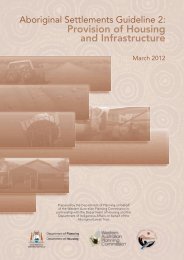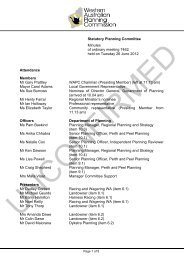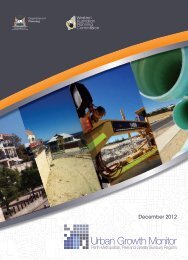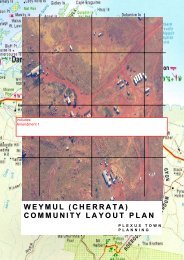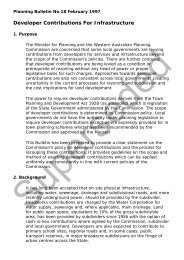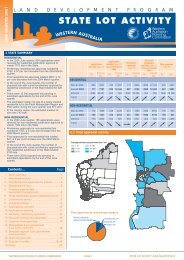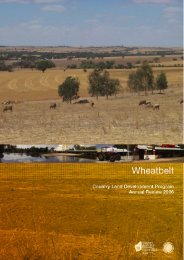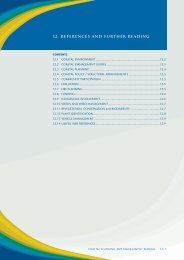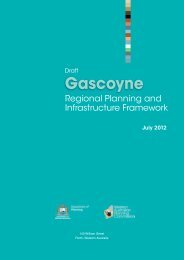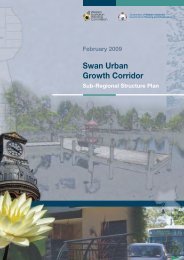CockburnCoast - Western Australian Planning Commission
CockburnCoast - Western Australian Planning Commission
CockburnCoast - Western Australian Planning Commission
Create successful ePaper yourself
Turn your PDF publications into a flip-book with our unique Google optimized e-Paper software.
<strong>CockburnCoast</strong><br />
It is envisaged that the majority of stormwater from both roadways<br />
and private property will be disposed via underground soaks. The<br />
location of this infrastructure will be determined at subsequent<br />
planning stages.<br />
2.12.4.2 Water management recommendations<br />
The following summarises the conclusions and management actions<br />
recommended in the urban water management overview.<br />
Groundwater<br />
Groundwater on the site is generally deep and therefore is not a<br />
constraint to development. However, the use of groundwater on the<br />
site has its risks, primarily the risk of salt water incursion and the<br />
historical contamination that has occurred from previous land uses<br />
such as landfills and industrial sites. Therefore the use of<br />
groundwater on the site is not recommended.<br />
Stormwater<br />
Due to the potential constraints on groundwater use in the structure<br />
plan area, opportunities to utilise as much stormwater runoff as<br />
possible should be encouraged.<br />
Stormwater on the site is currently infiltrated through a series of<br />
fenced sumps. These are unappealing and not considered<br />
appropriate for high-density residential areas. Drainage swales and<br />
basins can be incorporated into the east-west open space<br />
corridors. The location of the corridors takes advantage of the<br />
natural catchments, requiring minimal reworking over much of the<br />
site to achieve a suitable gradient.<br />
Based on the site geology much of the structure plan site is<br />
considered suitable for on-site disposal of storm water by soakage<br />
(soakwells and direct recharge via basins and passive community<br />
open space and landscaped soakage areas). The east-west<br />
corridors of green space can provide drainage opportunities as well<br />
as flora and active open space interconnections.<br />
The infiltration of stormwater on contaminated sites can cause<br />
contaminants to enter the groundwater. This issue may be<br />
addressed through site remediation and/or not infiltrating<br />
stormwater on contaminated sites. This issue will need to be<br />
addressed prior to the design of the new stormwater system.<br />
Potable water use reduction<br />
The development at Cockburn coast is of a medium to high density<br />
residential type and most dwellings will have little or no garden. The<br />
potable water use per house is likely to be significantly less than for<br />
a conventional low density development.<br />
Requiring home builders and developers to install water wise fittings<br />
and appliances is likely to be the most cost-effective way to reduce<br />
water use.<br />
Potential sources for domestic ‘third pipe’ systems for toilet flushing<br />
and washing machines include rainwater from roofs, the Port<br />
Catherine injection bore, grey water and recycled wastewater.<br />
Groundwater in the area may not be of an appropriate standard to<br />
be used in the irrigation of public open space. If this is the case,<br />
possible sources of water include the Port Catherine injection bore<br />
and recycled wastewater.<br />
2.12.4.3 Additional work required<br />
The following is a list of some key work that requires consideration<br />
following the conclusion of the structure plan. Irrespective of the<br />
ultimate administrative vehicle that will manage the development of<br />
the Cockburn coast, the following work is considered necessary<br />
during the detailed planning phases for Cockburn coast:<br />
• Given Department of Water requirements for<br />
predevelopment groundwater monitoring, the multiple land<br />
ownership and the probable complexity of groundwater<br />
contamination issues, it is recommended that a districtlevel<br />
groundwater monitoring program be initiated as soon<br />
as is practical. While probably not eliminating the need<br />
for lot-level groundwater investigations, the district<br />
monitoring program will assist individual landowners<br />
define their groundwater contamination issues and<br />
therefore costs incurred may be recoverable by scheme<br />
contributions;<br />
• Review and survey of the existing drainage system;<br />
• Seek the advice of the Department of Water and the<br />
Department of Environment and Conservation with respect<br />
to the infiltration of stormwater on and adjacent to<br />
potentially contaminated sites in the area;<br />
• Gain a broad spatial understanding of what sites will not<br />
be remediated and/or do not meet other criteria for<br />
infiltration and overlay the local structure plan to determine<br />
areas suitable for infiltration and the stormwater system<br />
design;<br />
• Broad design work for water, wastewater and stormwater<br />
infrastructure to service the new development, including<br />
infrastructure locations;<br />
• Undertake costing and feasibility studies for alternative<br />
water supplies, including negotiations with regulators to<br />
determine the preferred potable water management<br />
strategies; and<br />
• Conduct a water audit on existing and new commercial<br />
premises to assess the options for alternative water<br />
supplies on a case by case basis.<br />
2.12.4.4 Manning Lake management<br />
The location of Manning Lake within the structure plan area limits the<br />
potential for development to have an adverse impact. The plan<br />
proposes the alignment of Cockburn Coast Drive to be located on<br />
the western side of the ridge, consistent with the MRS zoning for this<br />
regional road. Other development proposed is also on the western<br />
side of the ridge which has been identified as a surface water<br />
divide. Direct impacts from development are therefore considered<br />
to represent a minimal risk to Manning Lake. In the event that road<br />
construction works to impact upon the eastern side of the ridge, it is<br />
recommended that the road management plan includes the<br />
consideration of sediment and runoff containment to limit the<br />
potential risks to the Manning Lake environs.<br />
Over-extraction of groundwater and the potential for saltwater<br />
incursion represent the only apparent direct risk to Manning Lake<br />
from the development of the Cockburn coast. Evidence exists that<br />
suggests the salt water wedge extends as far inland as Manning<br />
Lake. Impacts on the relationship between the salt water wedge<br />
and lens of fresh water above the wedge could alter the salinity<br />
levels in Manning Lake. Groundwater extraction is not<br />
recommended in the Cockburn coast area without further<br />
assessment and modelling of this issue.<br />
district structure plan<br />
43



